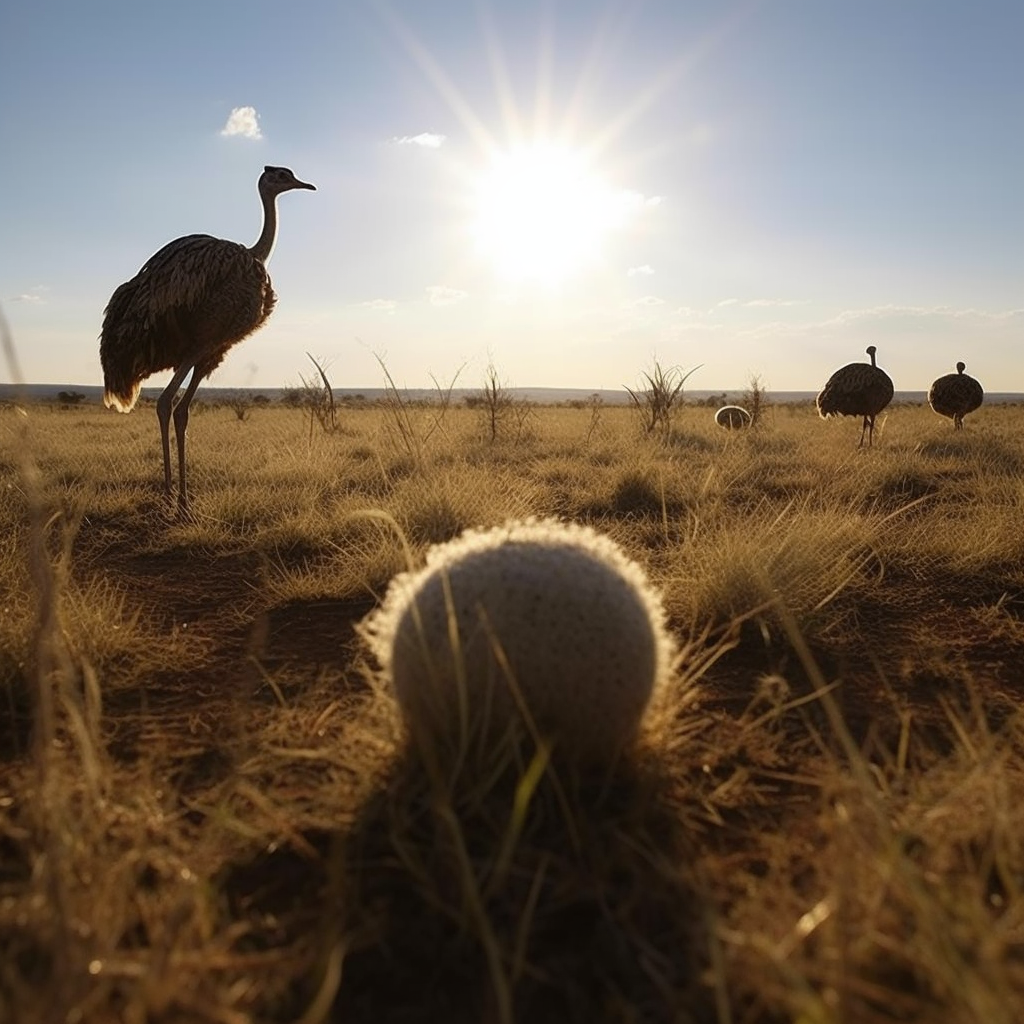Ostriches, the largest living species of bird, are known for their impressive size and unique characteristics. These flightless birds are native to Africa and are famous for their ability to run at incredible speeds. However, one aspect of their life cycle that often piques curiosity is their reproductive behavior. In this article, we will explore the fascinating topic of how often ostriches lay eggs. We will delve into the frequency of their egg-laying, the factors that influence it, and other interesting facts about ostrich reproduction. So, let’s dive in and uncover the secrets of these magnificent birds!
Key Takeaways
- Ostriches lay eggs less frequently compared to other birds.
- Female ostriches typically lay around 40 to 60 eggs per year.
- Ostriches lay their eggs in communal nests, with multiple females contributing to the same nest.
- The incubation period for ostrich eggs is approximately 42 to 46 days.
- Ostrich eggs are the largest of any bird species, weighing around 1.4 kilograms on average.
Understanding Ostrich Reproduction
Reproduction is a fascinating aspect of the ostrich‘s life cycle. These magnificent birds have unique breeding behaviors and reproductive cycles that are worth exploring. In this section, we will delve into the ostrich breeding cycle and the role of fertility in ostrich egg laying.
A. The Ostrich Breeding Cycle
The ostrich breeding cycle is an intricate process that involves various stages. Ostriches reach sexual maturity at around two to four years of age, although this can vary between individuals. Once they reach this stage, they are ready to breed and lay eggs.
In the wild, ostriches typically breed during the rainy season, which provides optimal conditions for egg incubation and chick survival. However, in captivity, ostriches can breed throughout the year, as they are not dependent on specific climatic conditions.
Ostriches are polygamous, meaning that one male will mate with multiple females. The male ostrich establishes a territory and attracts females through elaborate courtship displays. These displays involve fluffing their feathers, spreading their wings, and performing a unique dance to impress the females.
Once a male ostrich successfully attracts a female, they will form a monogamous pair and engage in mating behavior. The female will lay her eggs in a communal nest, which is typically a shallow depression in the ground. The female can lay up to 60 eggs in a single breeding season, although the average is around 20 to 30 eggs.
B. The Role of Fertility in Ostrich Egg Laying
Fertility plays a crucial role in ostrich egg laying. Female ostriches are incredibly fertile and can lay eggs every two to three days during the breeding season. However, it’s important to note that not all eggs are fertile.
The fertility rate of ostrich eggs varies depending on various factors, including the age and health of the female ostrich. Younger females tend to have a higher fertility rate, while older females may experience a decline in fertility.
Once the female ostrich lays her eggs, she will incubate them for approximately 42 to 46 days. During this incubation period, the female will rotate the eggs regularly to ensure even heat distribution and proper development of the embryos.
It’s worth mentioning that ostrich eggs are the largest eggs laid by any bird species. They are about 6 to 8 inches in diameter and can weigh up to 3 pounds. The size and weight of ostrich eggs make them highly sought after by collectors and artisans for their decorative and artistic value.
In conclusion, understanding the ostrich breeding cycle and the role of fertility in ostrich egg laying provides valuable insights into the reproductive behavior of these remarkable birds. From their elaborate courtship displays to the incubation of their large eggs, ostriches exhibit fascinating reproductive strategies that contribute to their survival and perpetuation as a species.
How Often Does an Ostrich Lay an Egg?

A. The Frequency of Egg Laying in Ostriches
When it comes to the frequency of egg laying, ostriches are quite remarkable. These magnificent birds are known for their ability to produce a large number of eggs, making them one of the most prolific egg-laying species in the avian world.
In the wild, female ostriches typically lay eggs once every two to three days during the breeding season, which usually occurs from March to September. However, it’s important to note that the frequency of egg laying can vary depending on various factors such as the age and health of the female ostrich.
B. Comparing Ostrich Egg Laying to Other Birds
Compared to other birds, ostriches have a unique egg-laying pattern. While most birds lay eggs on a daily basis, ostriches take a slightly different approach. Instead of laying eggs every day, female ostriches lay eggs every few days, as mentioned earlier.
This difference in egg-laying frequency can be attributed to the size and characteristics of ostrich eggs. Ostrich eggs are the largest eggs laid by any bird species, weighing around 3 to 5 pounds (1.4 to 2.3 kilograms) on average. Due to their large size, it takes more time and energy for female ostriches to produce each egg. Therefore, they require a longer interval between egg-laying sessions compared to birds that lay smaller eggs.
Another interesting aspect of ostrich egg laying is that it is not limited to just one female. In a group of ostriches, multiple females may lay their eggs in a single nest, which is usually constructed by the dominant female. This cooperative nesting behavior allows for efficient incubation and protection of the eggs.
It’s worth noting that ostriches are not the only birds that lay eggs with a longer interval between each laying session. Other large birds such as emus and cassowaries also exhibit similar egg-laying patterns. This suggests that the size of the eggs plays a significant role in determining the frequency of egg laying in these species.
In conclusion, ostriches lay eggs every two to three days during the breeding season, which is a unique pattern compared to other birds. The size and characteristics of ostrich eggs contribute to this longer interval between each laying session. This fascinating aspect of ostrich reproduction showcases the remarkable adaptations these birds have developed over time.
The Peculiarities of Ostrich Egg Laying
A. Where Do Ostriches Lay Eggs?
Ostriches, the largest living birds on Earth, have some fascinating peculiarities when it comes to egg laying. Unlike most birds that build nests in trees or on the ground, ostriches prefer to lay their eggs in a unique manner. Instead of constructing nests, ostriches lay their eggs directly on the ground, often in shallow depressions they dig themselves.
These shallow nests are typically located in open areas, such as savannas or grasslands, where the eggs can be easily spotted and protected from predators. Ostriches are native to Africa, where they have adapted to the hot and dry conditions of the continent. This means that their choice of nesting locations is mainly influenced by the optimal climatic conditions required for successful egg incubation.
B. How Do Ostriches Lay Eggs?
Ostriches have a fascinating reproductive cycle that involves the female ostrich laying eggs and the male ostrich taking care of them. The female ostrich reaches sexual maturity at around two to three years of age, while the male ostrich reaches sexual maturity at around three to four years of age. Once they reach sexual maturity, ostriches are ready to breed and lay eggs.
The breeding season for ostriches varies depending on the region and the climate. In the wild, ostriches in Africa typically breed during the rainy season when food is abundant. However, in captivity or on ostrich farms, ostriches can breed throughout the year, thanks to the controlled environment and availability of food.
During courtship, the male ostrich performs an elaborate mating display to attract the female. This display involves fluffing up his feathers, spreading his wings, and circling around the female while making booming sounds. If the female is impressed, she will lay her eggs in the shallow nest prepared by the male.
On average, a female ostrich can lay up to 40 to 60 eggs per year, although this number can vary depending on factors such as age, health, and environmental conditions. Each egg is large, weighing around 1.4 kilograms (3 pounds) and measuring about 15 centimeters (6 inches) in length. Ostrich eggs are the largest eggs laid by any bird species.
Once the female has laid her eggs, the male ostrich takes over the responsibility of incubating them. The male will carefully cover the eggs with sand and soil to keep them warm and protected. Ostrich eggs have a long incubation period of around 35 to 45 days, during which the male diligently turns the eggs to ensure even heat distribution.
In conclusion, ostriches have unique nesting habits and reproductive behaviors. They lay their eggs directly on the ground in shallow nests, and the male ostrich takes on the role of incubating and caring for the eggs. With their large size and fascinating reproductive cycle, ostriches truly stand out in the avian world.
The Annual Cycle of Ostrich Egg Laying

A. How Many Times Do Ostriches Lay Eggs in a Year?
Ostriches, the largest birds in the world, have a fascinating reproductive cycle. Female ostriches typically lay eggs once a year, but the exact frequency can vary depending on various factors. In the wild, ostriches live in Africa and parts of Europe, while on ostrich farms, they are bred for commercial purposes.
The reproductive journey of an ostrich begins when a female ostrich reaches sexual maturity, which is around the age of three to four years. At this point, she becomes capable of laying eggs. However, it’s important to note that not all female ostriches lay eggs every year. Some may skip a year or two before laying eggs again.
In the wild, the frequency of egg-laying is influenced by environmental conditions and the availability of resources. Ostriches are adapted to survive in hot and dry conditions, and their breeding season often coincides with the optimal climatic conditions. Therefore, in areas with favorable conditions, female ostriches may lay eggs annually. However, in regions where resources are scarce or climatic conditions are less favorable, they may lay eggs less frequently.
On ostrich farms, where conditions are carefully controlled, female ostriches are often encouraged to lay eggs every year. This is done by providing them with optimal nutrition and creating an environment that mimics the ideal breeding conditions. As a result, the frequency of egg-laying on farms is generally higher compared to the wild.
B. How Many Eggs Does an Ostrich Lay a Month?
On average, a female ostrich can lay around 40 to 60 eggs per year. However, it’s important to note that this number can vary depending on individual ostriches and their specific circumstances. In the wild, where resources are limited, female ostriches may lay fewer eggs compared to those on farms.
When a female ostrich is ready to lay eggs, she will typically lay one egg every two days. The entire egg-laying process can take several weeks to complete. Ostrich eggs are the largest of any bird species, weighing around 1.4 kilograms (3 pounds) on average. They have a unique shape and can be quite sturdy, making them well-suited for the harsh environments in which ostriches live.
Once the eggs are laid, they are typically incubated by the female during the day and by the male during the night. Ostriches are known for their monogamous mating behavior, with both parents taking turns to care for the eggs. The incubation period for ostrich eggs is approximately 35 to 45 days.
In conclusion, ostriches lay eggs once a year, with the exact frequency depending on various factors such as environmental conditions and resource availability. Female ostriches can lay around 40 to 60 eggs per year, with one egg being laid every two days. The eggs are then incubated by both parents until they hatch, which takes around 35 to 45 days.
The Lifespan of Ostrich Egg Laying
A. How Long Do Ostriches Lay Eggs?
Ostriches are fascinating birds known for their large size and unique reproductive habits. One of the most intriguing aspects of ostrich reproduction is their egg-laying behavior. So, how often do ostriches lay eggs?
Unlike many other bird species, ostriches do not lay eggs every year. Instead, they have a more sporadic egg-laying pattern. Female ostriches typically start laying eggs when they reach sexual maturity, which is around 2 to 4 years of age. However, it’s important to note that this can vary depending on the individual ostrich and environmental factors.
On average, a female ostrich will lay around 40 to 60 eggs in her lifetime. This may seem like a lot, but it’s important to remember that ostriches have a long lifespan, with some individuals living up to 40 or even 50 years. The frequency of egg-laying can vary greatly, with some females laying eggs every few months, while others may only lay eggs once or twice a year.
B. The Age Factor in Ostrich Egg Laying
The age of the ostrich plays a significant role in its egg-laying behavior. Younger females tend to lay fewer eggs compared to older, more experienced females. This is because younger ostriches are still maturing and may not have reached their peak reproductive capacity.
As female ostriches age, their egg-laying frequency tends to increase. This is especially true for females between the ages of 5 and 15, which is considered the prime reproductive period for ostriches. During this time, females are more likely to lay eggs regularly, with some individuals producing up to 30 eggs per year.
However, as ostriches reach their later years, their egg-laying frequency may start to decline. This is a natural part of the aging process, and it’s not uncommon for older females to lay fewer eggs or even stop laying altogether. Factors such as hormonal changes and overall health can influence the egg-laying behavior of older ostriches.
In conclusion, ostriches have a unique egg-laying pattern compared to other bird species. While they do not lay eggs every year, female ostriches can produce a significant number of eggs throughout their lifetime. The frequency of egg-laying varies among individuals and is influenced by factors such as age and overall health. Understanding the lifespan of ostrich egg-laying provides valuable insights into the reproductive behavior of these magnificent birds.
The Frequency of Unfertilized Ostrich Eggs
A. How Often Do Ostriches Lay Unfertilized Eggs?
Ostriches are known for their impressive ability to lay eggs, but have you ever wondered how often they lay unfertilized eggs? Let’s explore the frequency of unfertilized ostrich eggs and gain a deeper understanding of this fascinating aspect of ostrich reproduction.
Ostriches are highly prolific egg layers, with females capable of laying a significant number of eggs throughout their lifetime. However, it’s important to note that not all of these eggs are fertilized. In fact, a large portion of the eggs laid by ostriches are unfertilized.
The exact frequency of unfertilized eggs can vary depending on various factors, including the age and health of the female ostrich. Generally, a female ostrich will lay one egg every two to three days during the peak breeding season, which typically occurs in the spring and summer months. However, it’s important to note that not all of these eggs will be fertilized.
B. The Impact of Unfertilized Eggs on Ostrich Egg Laying Frequency
The presence of unfertilized eggs can have an impact on the overall frequency of ostrich egg laying. When a female ostrich lays an unfertilized egg, it triggers a hormonal response that stimulates her to lay another egg. This means that the presence of unfertilized eggs can actually increase the frequency of egg laying in female ostriches.
In the wild, where ostriches have to contend with various environmental factors and predators, this increased frequency of egg laying can be advantageous. By laying more eggs, the female ostrich increases the chances of successfully producing offspring. This strategy helps to ensure the survival of the species in the face of potential threats.
On ostrich farms, where the conditions are carefully controlled, the impact of unfertilized eggs on egg laying frequency may be less pronounced. However, it is still an important factor to consider when managing ostrich breeding programs. By monitoring the frequency of unfertilized eggs, farmers can gain valuable insights into the reproductive health of their ostriches and make informed decisions to optimize egg production.
In conclusion, ostriches lay unfertilized eggs quite frequently, with a large portion of their egg production being unfertilized. The presence of unfertilized eggs can actually stimulate female ostriches to lay more eggs, increasing the overall frequency of egg laying. This adaptive strategy ensures the survival of the species in the wild and plays a role in managing ostrich breeding programs on farms. Understanding the frequency of unfertilized eggs is crucial for anyone interested in the fascinating world of ostrich reproduction.
The Timing of Ostrich Egg Laying
Ostriches, the largest living bird species, have a fascinating reproductive cycle. Let’s explore when and how often ostriches lay eggs, as well as the impact of seasons on their egg-laying patterns.
A. When Do Ostriches Lay Eggs?
Ostriches are known for their impressive egg-laying abilities. Female ostriches typically start laying eggs when they reach sexual maturity, which is around the age of 2 to 4 years old. However, it’s important to note that the exact timing can vary between individuals.
In the wild, ostriches generally lay eggs during the breeding season, which typically occurs in the cooler months. This seasonality is influenced by the availability of food and favorable environmental conditions. Ostriches in captivity, such as on ostrich farms, may have different egg-laying patterns due to controlled environments and breeding practices.
B. The Seasonal Impact on Ostrich Egg Laying
The breeding season plays a significant role in determining when ostriches lay their eggs. In the wild, ostriches in Africa and parts of Europe tend to lay eggs during the cooler months, which are often characterized by hot and dry conditions. These conditions are considered optimal for egg incubation and hatching.
During the breeding season, male ostriches engage in courtship displays to attract females. Once a pair forms a bond, the female will lay her eggs in a communal nest, which is typically a shallow depression in the ground. This nest is often lined with vegetation and is shared by multiple females.
The female ostrich is responsible for laying the eggs, while the male takes on the role of incubating them during the day. This division of labor allows the female to focus on producing more eggs while the male ensures their safety and proper development.
On average, a female ostrich can lay around 40 to 60 eggs per year, although this number can vary. The eggs are large and have a unique shape, making them the largest of any bird species. They have a thick and hard shell, which provides protection for the developing embryo.
The incubation period for ostrich eggs is approximately 42 to 46 days. During this time, the male ostrich diligently turns the eggs several times a day to ensure even heat distribution and proper development. Once the eggs hatch, the chicks are precocial, meaning they are relatively independent and can walk and feed themselves shortly after hatching.
In conclusion, ostriches lay eggs when they reach sexual maturity, typically around 2 to 4 years old. The timing of egg laying is influenced by the breeding season, which is often during the cooler months in the wild. Female ostriches can lay around 40 to 60 eggs per year, and the eggs have a long incubation period of approximately 42 to 46 days. The male ostrich takes on the responsibility of incubating the eggs during the day, while the female focuses on producing more eggs. This remarkable reproductive cycle showcases the unique adaptations of ostriches in ensuring the survival of their species.
The Intricacies of Ostrich Egg Laying

A. How Often Can an Ostrich Lay an Egg?
Ostriches, the largest living bird species, have a fascinating reproductive cycle. Female ostriches typically lay eggs once every two days during the breeding season, which usually occurs between March and September. However, it’s important to note that the frequency of egg-laying can vary depending on various factors such as age, health, and environmental conditions.
During the breeding season, a female ostrich can lay an average of 40 to 60 eggs. This impressive egg production is due to the fact that ostriches are polygamous, meaning that one male ostrich mates with multiple females. This allows for a higher rate of egg-laying compared to monogamous bird species.
B. Why Do Ostriches Lay Eggs?
Ostriches lay eggs for the same reason as any other bird species – reproduction. The primary purpose of laying eggs is to ensure the survival and continuation of the species. Female ostriches invest a significant amount of time and energy into producing and incubating their eggs to ensure the successful hatching of healthy chicks.
In the wild, ostriches lay their eggs in communal nests called scrapes. These nests are typically shallow depressions in the ground, lined with grass, leaves, and other materials. The female ostrich takes on the responsibility of incubating the eggs, while the male ostrich guards the nest and helps protect it from potential predators.
The incubation period for ostrich eggs is approximately 35 to 45 days. This lengthy incubation period is necessary for the development of the chicks inside the eggs. Once the eggs hatch, the female ostrich takes on the role of caring for and raising the chicks, while the male ostrich continues to protect the family.
It’s worth mentioning that ostrich farming has become a popular industry in many parts of the world. Ostrich farms are established to meet the demand for ostrich products such as meat, feathers, and leather. These farms carefully manage the egg-laying process to maximize production and ensure the health and well-being of the ostriches.
In conclusion, ostriches lay eggs once every two days during the breeding season, with an average of 40 to 60 eggs per female. The purpose of egg-laying is to reproduce and continue the species. Female ostriches invest a significant amount of time and energy into incubating their eggs, while the male ostrich guards the nest. Ostrich farming has also become a popular industry, with farms carefully managing the egg-laying process for maximum production. Conclusion
In conclusion, ostriches are fascinating birds known for their large size and unique characteristics. They are the largest living species of bird and have the ability to lay the largest eggs of any bird species. Ostriches are highly productive when it comes to egg-laying, with females typically laying one egg every two days during the breeding season. This means that on average, ostriches can lay anywhere from 40 to 60 eggs per year. The incubation period for ostrich eggs is around 42 to 46 days, during which the male takes on the responsibility of incubating the eggs. Ostrich eggs are not only impressive in size but also have a thick and durable shell, making them highly sought after for various purposes. Whether it’s for reproduction or commercial use, the frequency at which ostriches lay eggs is truly remarkable and adds to the allure of these magnificent birds.
Frequently Asked Questions
Q1: How often does an ostrich lay an egg?
An ostrich typically lays an egg every 1-2 days during the breeding season, which can last several months. This frequency can vary depending on factors such as the ostrich‘s health, age, and environmental conditions.
Q2: How often do ostriches lay unfertilized eggs?
Ostriches can lay unfertilized eggs, but the frequency is less predictable. It largely depends on whether the ostrich is mating and the fertility rate of the individual bird. If an ostrich is not mating, all eggs laid will be unfertilized.
Q3: Where do ostriches lay eggs?
Ostriches lay their eggs in communal nests that are shallow holes dug in the ground by the male. These nests can be quite large, with a diameter of up to 3 meters, and are usually situated in open areas with good visibility.
Q4: How frequently do ostriches lay eggs?
During the breeding season, a healthy, mature ostrich can lay an egg every 1-2 days. This results in approximately 15-20 eggs per month.
Q5: How many times do ostriches lay eggs in a year?
The number of times an ostrich lays eggs in a year depends on the length of its breeding season, which can vary based on geographical location and environmental conditions. On average, an ostrich may lay around 40-60 eggs in a year.
Q6: How many eggs does an ostrich lay a month?
On average, an ostrich lays about 15-20 eggs per month during the breeding season. However, this can vary depending on the ostrich‘s health and age, as well as environmental factors.
Q7: How long do ostriches lay eggs?
Ostriches lay eggs for several months during the breeding season, which typically occurs once a year. The exact duration can vary based on factors such as the ostrich‘s age, health, and environmental conditions.
Q8: How does an ostrich lay eggs?
An ostrich lays eggs through the same process as other birds. The female ostrich will squat down and push the egg out of her body. The egg will then be incubated, either by the female, the male, or both, until it hatches.
Q9: When do ostriches lay eggs?
Ostriches lay eggs primarily during their breeding season, which can vary based on geographical location but typically occurs once a year. The exact timing can also depend on factors such as the ostrich‘s age and health.
Q10: Why do ostriches lay eggs?
Ostriches lay eggs as part of their reproductive cycle. The eggs, if fertilized, will hatch into baby ostriches. Even if the eggs are not fertilized, the female ostrich will still lay eggs during the breeding season.




